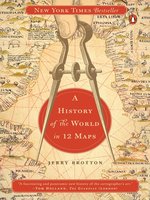“Maps allow the armchair traveler to roam the world, the diplomat to argue his points, the ruler to administer his country, the warrior to plan his campaigns and the propagandist to boost his cause… rich and beautiful.” – Wall Street Journal
Throughout history, maps have been fundamental in shaping our view of the world, and our place in it. But far from being purely scientific objects, maps of the world are unavoidably ideological and subjective, intimately bound up with the systems of power and authority of particular times and places. Mapmakers do not simply represent the world, they construct it out of the ideas of their age. In this scintillating book, Jerry Brotton examines the significance of 12 maps - from the almost mystical representations of ancient history to the satellite-derived imagery of today. He vividly recreates the environments and circumstances in which each of the maps was made, showing how each conveys a highly individual view of the world. Brotton shows how each of his maps both influenced and reflected contemporary events and how, by considering it in all its nuances and omissions, we can better understand the world that produced it.
Although the way we map our surroundings is more precise than ever before, Brotton argues that maps today are no more definitive or objective than they have ever been. Readers of this beautifully illustrated and masterfully argued book will never look at a map in quite the same way again.
“A fascinating and panoramic new history of the cartographer’s art.”
– The Guardian
“The intellectual background to these images is conveyed with beguiling erudition…. There is nothing more subversive than a map.”
– The Spectator
“A mesmerizing and beautifully illustrated book.”
—The Telegraph
“Maps allow the armchair traveler to roam the world, the diplomat to argue his points, the ruler to administer his country, the warrior to plan his campaigns and the propagandist to boost his cause… rich and beautiful.” – Wall Street Journal
Throughout history, maps have been fundamental in shaping our view of the world, and our place in it. But far from being purely scientific objects, maps of the world are unavoidably ideological and subjective, intimately bound up with the systems of power and authority of particular times and places. Mapmakers do not simply represent the world, they construct it out of the ideas of their age. In this scintillating book, Jerry Brotton examines the significance of 12 maps - from the almost mystical representations of ancient history to the satellite-derived imagery of today. He vividly recreates the environments and circumstances in which each of the maps was made, showing how each conveys a highly individual view of the world. Brotton shows how each of his maps both influenced and reflected contemporary events and how, by considering it in all its nuances and omissions, we can better understand the world that produced it.
Although the way we map our surroundings is more precise than ever before, Brotton argues that maps today are no more definitive or objective than they have ever been. Readers of this beautifully illustrated and masterfully argued book will never look at a map in quite the same way again.
“A fascinating and panoramic new history of the cartographer’s art.”
– The Guardian
“The intellectual background to these images is conveyed with beguiling erudition…. There is nothing more subversive than a map.”
– The Spectator
“A mesmerizing and beautifully illustrated book.”
—The Telegraph








